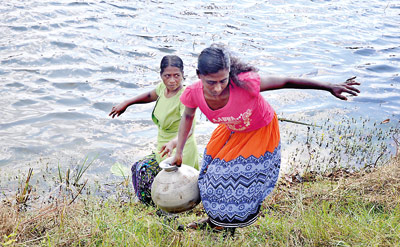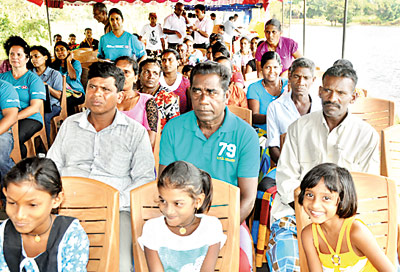A life-sustaining collaboration

Water close at hand: A boon to villagers. Pix by Nilan Maligaspe
Do not release even a drop of rainwater to the sea without first utilising it” –King Parakramabahu’s wisdom of old highlights the importance of water conservation. Anyone who has been to Anuradhapura or any other area in the dry zone of Sri Lanka would understand – rain is scarce in these areas and water conservation vital for survival. Our ancient kings built tanks for this purpose so that villagers would not be denied this life-sustaining resource.
The Kapiriggama cascade tank system connects 22 tanks. This means that the water from one tank flows to the next tank, and then the next so that the water is recycled not once, not twice but six times. This ancient cascade tank which benefits 600 families in the area was recently restored under a Corporate Social Responsibility project undertaken by the Honkong and Shanghai Banking Corporation (HSBC) in collaboration with the International Union for Conservation of Nature (IUCN).
This ancient tank system connects a number of tanks together and allows better utilisation of water than a single tank used in isolation would. The presence of water in these tanks also increases the amount of ground water present within the wells of the area, making the water accessible to many. However, these tank systems need to be maintained carefully for if one tank is not viable, the entire system fails. The Kapiriggama cascade tank system had many issues which were fixed through this project over the past three years.
One of the main tanks restored was the Puliyankulama tank, which had a leak that led to the loss of 50 per cent of the tank water. No matter how hard it rained, the water would leak out within a week and the villagers would be compelled to walk to the neighbouring village, which was around three kilometres away, in order to collect drinking water or to bathe, villagers said.
The villagers were directly involved in the restoration of the tank, under the project initiated by HSBC which also provided funding, with the IUCN providing the technical expertise needed in order to restore the tanks correctly. They contributed the labour needed to restore the tank system.

Coming together: Members of the community and HSBC officials
K. Thilakarathne, president of the village community society, feels that the effort they invested has reaped many benefits to the whole community. A lake which could only provide them with enough water to farm three acres before now allows them to cultivate 25 acres of land, he said.
Empowering the villagers was another key aim of this project. The IUCN worked closely with the villagers in order to teach them about organic farming, proper use of fertilizer, and most importantly how to maintain the tanks which were restored. A community leader Lal Gunasiri voiced the villagers’ gratitude when he said that until this project, no one helped them although they requested help many times.
Despite the obvious benefits, the project didn’t get off to a good start. Initially wary that the IUCN spent over a year measuring the land and the lakes in order to analyse the data and figure out the best way forward, the villagers however warmed to the idea once volunteers from HSBC began visiting the area and contributing their labour.
“This project is about reviving an ancient irrigation system that has formed the backbone of the cultural, social and economic fabric of these communities for thousands of years,” said CEO of HSBC for Sri Lanka and the Maldives, Patrick Gallagher at a ceremony held to mark the completion of the project. IUCN Country Representative Dr. Ananda Mallawatantri felt the availability of water promotes food security which in turn allows the villagers to devote their time towards other endeavours which would enrich their lives culturally and spiritually.
Noting that the Kapiriggama cascade tank system is one of the oldest uninterrupted tank systems present in the world, Head of IUCN’s Water Management Division, engineer Prabath Witharana said its restoration is important culturally as well as agriculturally.
The knowledge and expertise the IUCN gained while restoring this system which is over 2,500 years old will be used when restoration of any other cascade tank system is done. Project Manager for the IUCN Kumudu Herath remarked that the extensive research done by the IUCN before attempting to restore the system will ensure that the cascade system can be maintained in the future years to come.
At the official handing over ceremony, the excitement of the villagers was palpable and they were full of gratitutude towards the team who had helped transform the Puliyankulama tank from one which was barely usable to a tank which could hold enough water for all their needs. In fact, no one could even remember what it was like to see the tank filled with water for such a long period of time. P.C. Thinona, 83, said that she cannot remember a time when she has seen so much water collected in the tank and ready for harvest.


